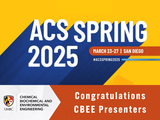CBEE Undergraduates Present at ACS Conference
Ariel Willson-Gray and Zorah Williams, CBEE undergraduates, participated in the ACS Spring 2025 Conference in San Diego, CA at the end of March. They each presented the innovative research they have been working on while at UMBC.
Ariel Willson-Gray is a Chemical Engineering undergraduate student on the Biotechnology and Bioengineering track who works in Dr. Almodovar’s lab. Ariel’s project explores how a layered surface of collagen and heparin can influence the properties and production of extracellular vesicles from living cells.
Ariel shared, “Although ACS is a chemistry-focused meeting, I had insightful conversations and connected with amazing researchers in biomedical engineering, who shared valuable insights about research and career paths in the field. I also had the pleasure of meeting Dr. John Macklin, from the University of Washington, whose background is in chemistry. He generously offered thoughtful advice and guidance on navigating STEM as a Black scientist, which I deeply appreciated.”
Zorah Williams is a Chemical Engineering undergraduate student on the Environmental Engineering and Sustainability Track. Zorah presented her summer research on behalf of the Institute of Marine and Environmental Technology (IMET) which focused on the role of filter-feeding organisms in improving water quality by reducing excess nutrients.
Zorah shared, “Throughout the conference, I had the chance to connect with students, researchers, and professionals from across the country and the world. It was an amazing experience getting to engage with other researchers, exchange ideas, and gain feedback on my work. I also had the chance to reconnect with a friend from high school who was also presenting, and we had a chance to see each other's work and catch up. This was also my first time visiting San Diego, and I really enjoyed trying local restaurants and exploring the city with other students. This was all made possible by the support of the Meyerhoff Program and UMBC. I highly encourage students to consider attending next year, as it's a valuable chance to grow professionally, make connections, and explore somewhere new!”
Read more about these students’ research below.
Poster Title: Production of Extracellular Vesicles from Mammalian Cells Modulated by a Biomimetic Surface
Authors: Ariel Wilson-Gray, Melanie Nelson, and Jorge Almodovar
Abstract: Extracellular vesicles (EVs) are nano-sized compartments secreted by cells as part of cellular signaling. Encased in a lipid bilayer, they carry proteins, lipids, and nucleic acids, making them promising candidates for drug delivery, diagnostics, and immunotherapy. However, conventional isolation methods face challenges due to EV variability. This study compares EV production from three cell types—NIH-3T3 fibroblasts, human Schwann cells, and human mesenchymal stem cells—using two isolation techniques: chemical isolation alone and in combination with centrifuge filtration. Findings show that integrating centrifuge filtration enhances purification, yielding smaller EVs associated with intercellular communication. Additionally, we investigate EV production on a biomimetic surface composed of heparin and collagen. Collagen facilitates sustained miRNA release, potentially improving EV therapeutic applications, while heparin inhibits EV transfer between cells, allowing for accumulation and improved isolation. Leveraging heparin’s affinity may provide an additional purification strategy. Future research will explore a collagen/heparin multilayer surface to further optimize EV isolation and composition, complementing existing methods. These advancements could enhance EV-based therapies, broadening their potential impact in medicine.
Poster Title: Evaluating the Impact of Suspension Feeders on Nutrient Levels in the Chesapeake Bay
Authors: Zorah Williams, Ronita Sequeira, Dr. Eric Schott
Abstract: This study assessed the ability of suspension-feeding communities to reduce chlorophyll levels in Baltimore Harbor by filtering out phytoplankton. The project explored the potential of filter-feeding species and whether these communities could positively impact water quality through phytoplankton uptake. The experimental setup consisted of two rafts: one with nylon straps that became populated by a biofouling community of mussels, barnacles, and other suspension feeders and a control raft with nylon straps but without biofouling. Both rafts were located in a part of Baltimore Harbor with high phytoplankton levels due to nutrient-rich urban runoff. Water samples were collected from within and adjacent to the two rafts, and phytoplankton were filtered onto glass fiber filters. Filters were extracted with ethanol, and chlorophyll levels were measured using fluorometry.
To ensure accuracy in chlorophyll measurements, we compared the performance of two fluorometers—a benchtop device and a handheld model—by analyzing their variance levels. This was achieved through a series of rhodamine standards where multiple samples of varying dilutions were measured in triplicate, and their coefficients of variance were calculated. The handheld fluorometer, with its lower variance, was confirmed to provide reliable readings for assessing chlorophyll readings of Chesapeake Bay samples. The extracted chlorophyll from the biofouling community and control rafts were measured, and the findings were statistically compared.
This research is part of a larger initiative to explore the ecosystem services provided by biofouling communities in urban estuaries. By assessing their role in particulate and nitrogen removal and investigating the potential for composting harvested biofouling organisms, this study creates valuable knowledge that may be used to use nature-based methods to better improve water quality.
Posted: April 25, 2025, 10:50 AM
